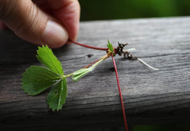Posted by Originally published by Sage Journal as part of the Autumn Gardening Series
27th Jun 2025
Winter strawberry guide | Growing & propagating your patch
The winter care guide for strawberries: How to grow, care for & propagate strawberries
Strawberries are much loved by home gardeners, and a must-have in any edible garden. They’re generous, low-maintenance fruiters — rewarding you with basket loads of delicious treats for very little effort. To set yourself up for summer harvests, the key time to begin is during winter months.
If you’re in a warmer climate, aim to plant from June to September. In regions with colder temperatures, snow-prone areas, late August — September is the best time to plant strawberries.
This guide covers both planting your strawberry beds with new plants, and maintaining an existing strawberry patch to keep its fruit production optimal for seasons to come.
Winter strawberry care and cold weather protection
During the winter months strawberry plants enter dormancy, but that doesn’t mean your patch should be ignored. Winter is a great time to inspect your strawberry beds for signs of winter injury, like blackened crowns or dying-off runners. Cold temperatures, especially a late spring frost arriving unexpectedly, can cause lasting winter damage. Protecting your young plants with row covers or applying a winter mulch helps buffer against frost damage and cold weather.
While the plants aren’t actively growing, winter is also a good time to prepare for the following year. If you’re planning a new bed, check the area and you can even do a soil test before planting. Aim for loose, well-drained soil amended with compost. Keep drainage in mind so you can reduce the risk of fungal diseases like gray mould during wet weather.
Choosing the right variety for your garden
It can feel a little overwhelming standing in front of rows of seemingly identical strawberry plants at the garden centre. But if you look close, you’ll find each variety offers something a little different — whether that’s a longer harvest season or a unique flavour profile.
Strawberry cultivars generally fall into two categories: short-day and day-neutral.
- Short-day varieties, like Pajaro and Camarosa, fruit earlier in spring.
- Day-neutral varieties, like Monterey and Sweet As, aren’t influenced by daylight length, so they fruit over a longer period with multiple flushes.
If your goal is an early, abundant spring harvest, opt for short-day types. If you’d prefer a steady supply of berries into the warmer months, day-neutral strawberries are the way to go.
For something a little more whimsical, try White Alpine Strawberries. These dainty wild berries have a distinctive flavour — sweet fruit, with hints of white chocolate. Their pale colour also keeps them hidden from birds, you’ll just have to beat the children to them!
Location, soil type & watering
Strawberries thrive in a sunny, sheltered spot. Though they love warmth, remember they are woodland natives at heart and appreciate a little afternoon shade. A lightweight netting can do double duty — offering shade from intense summer sun and keeping hungry birds away.
It’s best to plant strawberries into rich, fertile soil. It’s important to choose a spot with well-drained soil too.
Before planting, dig in generous amounts of compost, aged sheep manure/pellets or other organic matter.
In containers, use good quality potting mix and stay on top of feeding and watering.
Watering is key. Strawberries don’t like too much water or wet feet (they need good drainage), but letting them dry out (especially during fruiting season) will reduce their productivity.
Strawberry roots are shallow, so planting on raised mounds improves drainage. Make sure the crown of each plant is sitting just above the soil surface to prevent rot.
How many strawberry plants should I grow?
As many as you can fit!
To enjoy strawberries fresh, in baking and still have enough to freeze, you may need upwards of 20+ plants per person. But if you’re short on space, just 5 plants per person will give you small daily pickings — a bowlful of sun-warmed berries for breakfast or dessert.
Tending to an existing strawberry patch
If you already have strawberry plants in the ground, now’s the time for a winter tidy up.
Remove brown, dead leaves and weed around the crowns. If your plants are three years or older, it’s time to replace them — they’ll be past their prime.
You can either buy new plants from the nursery, or propagate your own from runners or by division.
How to propagate strawberry plants
There are two main methods:
- From runners – Young plantlets form on long stems sent out from the mother plant. These can be pegged down into pots to root before detaching.
- By division – Dividing older strawberry plants (lifting and separating at the crown) can refresh their vigour, give you more plants, and keep your patch productive. You will know when your plant is ready for division when it is more than three years old, and you may notice the plant is becoming very overgrown and crowded. The crown of the plant may even have started to die off, this is a common sign that they are due for a refresh.
Division is a good option in the winter if you find you need more plants quickly and have no more runners to propagate from.
How to divide a strawberry plant
- Lift the plant
- Gently dig around the base of the mature strawberry plant with a fork or trowel.
- Lift it out carefully, keeping as much root intact as possible.
- Examine the plant
- Shake or rinse away the soil to get a clear view of the crown.
- You may notice the central section is beginning to die back — a sign the plant is past its prime.
- Around the outside, you’ll see smaller, naturally formed offshoots known as offsets. Each one should have its own roots and a leafy growing point — these are what you’ll separate and replant.
- Divide the plant
- Using your hand or snips, split the crown into sections.
- Each division should have:
— A good root system
— A strong growing point with leaves - You can usually get 2-4 plants from one healthy parent plant.
- Replant immediately
- Plant each division into a small pot or straight into the ground.
- Make sure the crown (where leaves meet roots) is just above the soil surface.
- Firm in gently and water plants well.
These new plants will fruit reliably for another 2-3 years.
Fertilising & mulching
Winter is not the time to fertilise. Wait until early spring to apply a slow-release fertiliser suitable for fruiting plants to help with plant growth and fruit production.
After feeding, apply a straw mulch, pine needles, leaf litter or wood chips — anything that mimics the forest floor. This helps with weed control, lock in soil moisture, and keep ripening fruit from rotting on the soil.
Once your strawberries are in production, a fortnightly liquid feed will keep them flowering and fruiting.
Companion plants for strawberries
Companion planting is a lovely way to support your strawberry patch naturally.
- Nasturtiums are excellent — they help deter pests (and some dappled shade).
- Herbs like thyme and basil are good neighbours that can help improve taste.
- Flowers such as borage and marigold bring in the pollinators.
Remember winter is the quiet groundwork that leads to an overflowing summer garden and growing season. With a bit of attention now, your healthy plants will be ready to burst into spring with new growth and reward you for your efforts.
Whether you’re planting new strawberry plants or refreshing what’s already there, these small jobs now will make a big difference later.
________________________________________________
The Sage Journal Winter Gardening Series is supported by Gubba Garden Store.


























